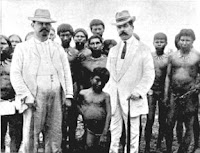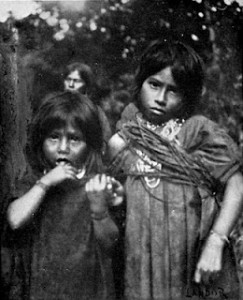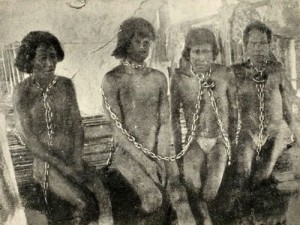Napo Runa Indians who regularly go to work for the oil companies often have themselves cleansed with tobacco smoke by a shaman when they return to their villages. They are having themselves healed of wage labor; they are being cleansed of capitalism. This is a small act of cultural resistance, affirming the validity of their traditional values over against those of their white employers.
Shamans are the knowledge-bearers of their cultures, repositories of myths, symbols, and values. The shaman embodies a cultural tradition, and may thus function as a catalyst for cultural resistance against oppression and assimilation.
This should not be surprising. Shamanic power is involved in all community affairs; it is thus inevitably involved in aggression, warfare, and the struggle for political and economic power. Dark shamanism and assault sorcery especially have been viewed as acts of political resistance, and thus as, essentially, acts of cultural healing. A dominant strand in the interpretation of South American shamanism has viewed it as resistance against the brutalities of colonialism, as an indigenous struggle for autonomy in the face of state control, and as a discourse about modernity — gun violence, slave trading, debt peonage, missionaries, epidemic disease, “the white man’s materiality and spirituality.” Sorcery is political.
 |
In this view, shamans play a role in resisting, ameliorating, and influencing the course of colonial contacts and history; they become the source and symbol of an indigenous culture capable of defending itself against colonial power and the national state. As one Putumayo shaman reportedly told anthropologist Michael Taussig, “I have been teaching people revolution through my work with plants.”
Sorcery, as a weapon of the weak, may be turned against the colonial oppressor, just as it may be used to enforce internal norms of sharing and generosity. It can function as a form of direct resistance — poisoning, killing, subverting the authority of colonial or oppressive powers. But such resistance may also involve multiple levels of irony. The colonizer, as cultural outsider, projects on the indigenous shaman the colonizing culture’s own presuppositions concerning sorcery and indigenous savagery. In turn, to be effective, the colonized sorcerer must conform to the expectations and presuppositions of the colonizer — indeed, for purposes of resistance, may reinforce and enhance such projections by emphasizing just those features of indigenous sorcery the colonizer finds most gruesome, repugnant, and therefore terrifying. And this is so whether the indigenous attack sorcery is actually practiced or is only an accusation people make against each other.
 |
This is the way Michael Taussig interprets shamanic healing in the Putumayo region of Colombia — as hidden political resistance to the terror and suffering experienced by the Indians during a brutal colonial history. Taussig originally came to Colombia as a dedicated Marxist physician, intending to minister to rural guerillas. While doing this work, Taussig became fascinated by the historical violence in the area — he became, he says, a violence junkie — and intrigued by the fact that the Huitoto Indians, the most oppressed and marginalized people in Colombian society, were credited with possessing magical power, which they then made available to poor white colonists in the form of ayahuasca healing sessions.
This power was in fact, he says, a projection by the white colonizers onto the shamanic other; to the magic already possessed by indigenous shamans, he says, “colonialism fused its own magic, the magic of primitivism.” The shaman then took this projected magical power, this image of shaman as wild man, to use in his own healing practice, which he made available to the civilized colonizer. And the shaman as suffering healer — indeed, suffering under the violence of the colonial state — comported with the official discourse of the colonial church.
 |
Thus the interaction of colonizer and shaman was not a one-way process where indigenous culture was passively acted upon by external forces; nor was the result an organic synthesis or syncretism. Rather the interaction was a “chamber of mirrors reflecting each stream’s perception of the other,” which “folds the underworld of the conquering society into the culture of the conquered, the peon, the slave.” In fact these forces came full circle, with the poor white colonists seeking redemption at the hands of the colonized indigenes; Taussig describes this encounter as one in which an indigenous shaman “heals the pain in the souls of the civilized.” So, through the sweep of colonial history, the colonizers provided the colonized with the left-handed gift of the image of the wild man — “a gift whose powers the colonizers would be blind to, were it not for the reciprocation of the colonized, bringing together in the dialogical imagination of colonization an image that wrests from civilization its demonic power.”
We need to be cautious, however, in applying such a grand narrative to the facts on the ground. Social anthropologist Caroline Humphrey, and expert on Mongolian shamanism, says that the shamanism Taussig describes is uniquely “reactive, absorptive, and frantically hyperaware of colonial powers and technology.” Anthropologist Michael Brown, who studied the shamanism of the Aguaruna of northeastern Perú, says that “society cannot be relegated to the conceptual status of a penal colony without … violating the complex and creative understandings of those for whom we presume to speak.”
Reducing shamanism to political resistance, Brown says, also undervalues the internal complexity of indigenous cultures, which have their own “internal fields of conflict and points of contention.” To the extent that resistance changes the distribution of power, status, and wealth, he says, it may challenge the internal status quo as much as it challenges the power of outsiders. Anthropologist Sherry Ortner puts it this way: “Resistors are doing more than simply opposing domination. They have their own politics.” And indigenous resistance to acculturation may be supported by those nominally the oppressor, for their own reasons — for example, wanting the natives to return to their own environment, safely in their communal houses, rather than living in the city and appointed, say, secretary of education.
Grand narratives of sociopolitical resistance, says medical anthropologist Arthur Kleinman, eventually undermine the genuine moral claims of indigenous suffering, and belittle “the personal pains and distress that sick persons bring to shamans, which shamans try to cure.” And we must be careful that, in characterizing the shaman as heroic resistor, we are not — once again — mythologizing the shaman to suit our own projected needs. Far from resisting biomedicine, for example, the Amazonian shaman has adopted its symbols and power; rather than being a static reservoir of tradition, preserving culturally intact knowledge, shamanism has created — as it always has — what Kleinman has called “an actively produced hybrid medicine.”

- Previous Post: New Studies of Psychedelics
- Next Post: Marshall Arisman, Shaman
- More Articles Related to: Indigenous Culture, Shamanism, The Amazon



Good stuff – some relevant information can be found in these two blog entries:
Modern Shamanism in a political context… and Interview with a Yachak.
Colonos — Thank you very much for those two references. You have a wonderful blog; I will do some exploring.
Your blog is great, too! :)
Excellent article. In the perspective of the ever-shifting perceptions of the Other in this ‘hall of mirrors,’ what would be your take on syncretic movements like the Santo Daime?
I read a good academic sociology article (it was in French and I can’t find the link any more) explaining that the Santo Daime was born in the seringuero communities of the Amazon in the wake of the collapse of South American rubber prices in the 1920s. Cheaper Asian rubber had become available. Amazon rubber tappers had lived in virtual indentured slavery to their employers, basically spending their life and life force trying to buy back their freedom by paying back the ‘debts’ they had incurred when they moved there from other parts of Brazil. Finding themselves suddenly free from that system, being neither ‘from’ the forest nor from somewhere else any more, many of them embraced a worldview that ‘indigenized’ them by ratifying their connection to the forest in spiritual terms. The article mentioned that the term ‘padrinho’ (godfather), used for Santo Daime leaders, was the term by which rubber plantation bosses were traditionally addressed, and they were in fact often the godfathers of the seringueros’ children.
This sociological perspective would also help us understand the importance of economic self-reliance and utopian projects in the Santo Daime.
The article also suggests that the founder was a physically very imposing man with unusual vitality who probably had less trouble than other rubber tappers earning his independence. He was welcome by that community as a leader who was able to provide both economic freedom and a deeper sense of connectedness to a place where many had worked all their lives or had even been born — ending up owning nothing.